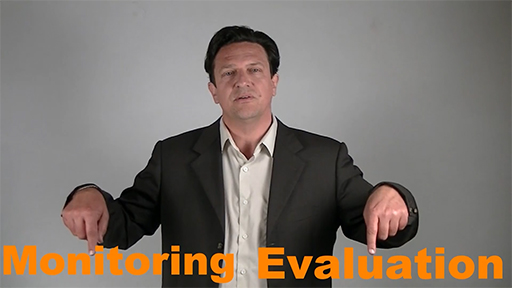3 Distinguishing between monitoring and evaluation
Monitoring and evaluation are two terms that are often found together, be it in project or programme proposals, reports, funding documents, even in the names of specific departments or organisations. Indeed, it is tempting to assume that monitoring and evaluation are one and the same. But is it necessarily right to bundle these two terms together?
In the next activity, you will explore monitoring and evaluation further.
Activity 3
In the following video Thomas Winderl, a consultant working in monitoring and evaluation in development, discusses how and why these two terms can be distinguished and why it is important to do so. Watch the video then answer the question that follows:

Transcript: Video 2 Monitoring evaluation
- What is the difference between monitoring and evaluation?
Note your answer in the box below.
Discussion
Winderl points out that these two processes take place at different stages and often by different actors. Monitoring requires ongoing, systemic collection and analysis of information in order to follow the development and progress of a project or programme and are usually carried out internally.
In contrast, evaluation tends to focus on the ‘what’ or the endpoint of the programme and is usually performed by people external to the organisation so that it is impartial and unbiased.
Delving deeper, the types of monitoring information gathered will be influenced by what it is you wish to assess – the outcomes, the process undertaken, or both. A distinction is sometimes made between outcomes-based and process-based monitoring and evaluation.
Whilst there are many different types of evaluation, results or outcomes-based evaluation is particularly focused on the ‘what’ or the endpoint of the project and so the collection of data will reflect this. To begin, baseline data is needed as you saw in Activity 2. To know that something has changed, you need to know your start point. If you are involved in a programme to improve the sanitation in a town with an overall aim of health improvement, you need to have some idea of the current situation and how it relates to your proposed endpoint. And of course, if the work is going to take place over a period of time, is taking up time and resources, and has a finite life, you will want to follow progress so that you can see if you are on track and going to meet your objectives in the allocated time.
Process-based evaluation focuses on the ‘how’ of the programme. Monitoring data will capture something of the particular path followed by you and your teams in achieving its goals. For instance, you wish to know how the management of the programme was undertaken, how staff were deployed, the challenges and opportunities that revealed themselves during execution.
As ever, nothing sits nicely in its boxes and monitoring with a process or results-based focus can merge and overlap. For instance, budgetary information is useful in deciding if the programme has delivered on its goals and according to what was planned (effectiveness), as well in assessing its efficiency in doing so. The usefulness of differentiating between outcomes and process is that it ensures you consider both the implementation and delivery dimensions of a programme, and so enables you to make informed decisions as to the type of monitoring data that you wish to gather.
This division of outcome and process-based monitoring and evaluation is in itself a rather crude simplification and does not reflect the diversity of approaches taken to evaluation practice and that a combination of approaches is likely to be used.
